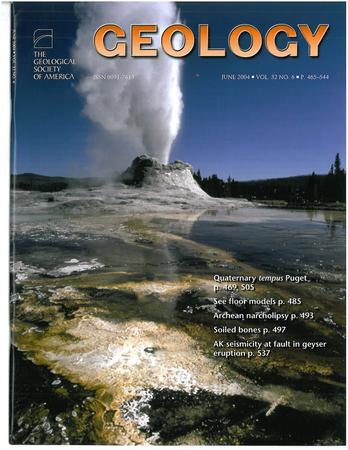锌同位素对百慕大地幔源区碳循环的约束
IF 4.6
1区 地球科学
Q1 GEOLOGY
引用次数: 0
摘要
地幔过渡带(MTZ)挥发物的再循环和储存对上地幔的再利用具有重要意义,并与高- μ (HIMU) (μ为238U/204Pb)地幔的生成有关。探测MTZ和与地幔对流相关的过程的一种方法是取样来自浅层地幔并被MTZ上升流污染的熔岩,如先前提出的百慕大浅层羽流。本文首次测定了百慕大硅质欠饱和和硅质饱和熔岩的δ66Zn同位素组成,以探讨北大西洋西部富碳岩性的成因和大型海山的成因。与全球δ66Zn数据相比,我们的δ66Zn在0.24±0.04 ~ 0.41±0.04之间,不支持百慕大HIMU地幔中再生海相碳酸盐的直接采样。相反,我们认为δ66Zn向高值分馏与岩浆过程和碳酸盐形成相关的深部流体碳的掺入有关。这些富碳流体可能来自约500 Ma的Iapetus海洋岩石圈俯冲冷板与泛大陆加厚的大陆岩石圈地幔之间的交代反应。晚新生代法拉龙板块通过浅层对流到达北美东部边缘,引发了这一交代地幔的融化。本文章由计算机程序翻译,如有差异,请以英文原文为准。
Zinc isotope constraints on the cycling of carbon in the Bermuda mantle source
Volatile recycling and storage in the mantle transition zone (MTZ) is important for the refertilization of the upper mantle and is associated with the generation of high-µ (HIMU, where µ is 238U/204Pb) mantle. One way to probe the MTZ and the processes associated with mantle convection is to sample lavas that originate from the shallow mantle and were contaminated by upwelling from the MTZ, such as at the previously proposed shallow plume of Bermuda. Here we present the first δ66Zn isotopic compositions of Bermuda silica-undersaturated and silica-saturated lavas to explore the origin of the carbon-rich lithologies and the genesis of the large seamount found in the western North Atlantic Ocean. Contrasting with global δ66Zn data sets, our results (δ66Zn between 0.24 ± 0.04 and 0.41 ± 0.04) do not support direct sampling of recycled marine carbonates in the Bermuda HIMU mantle. Instead, we show that δ66Zn fractionation toward higher values is associated with magmatic processes and incorporation of carbon sourced from deep fluids associated with the formation of carbonatites. These carbon-rich fluids are likely sourced from the metasomatic reactions between the subducted cold slab of the Iapetus oceanic lithosphere ca. 500 Ma and the thickened continental lithospheric mantle of Pangea. Melting of this metasomatized mantle was triggered by the arrival of the Farallon slab to the eastern North American margin in the late Cenozoic via shallow convection.
求助全文
通过发布文献求助,成功后即可免费获取论文全文。
去求助
来源期刊

Geology
地学-地质学
CiteScore
10.00
自引率
3.40%
发文量
228
审稿时长
6.2 months
期刊介绍:
Published since 1973, Geology features rapid publication of about 23 refereed short (four-page) papers each month. Articles cover all earth-science disciplines and include new investigations and provocative topics. Professional geologists and university-level students in the earth sciences use this widely read journal to keep up with scientific research trends. The online forum section facilitates author-reader dialog. Includes color and occasional large-format illustrations on oversized loose inserts.
 求助内容:
求助内容: 应助结果提醒方式:
应助结果提醒方式:


